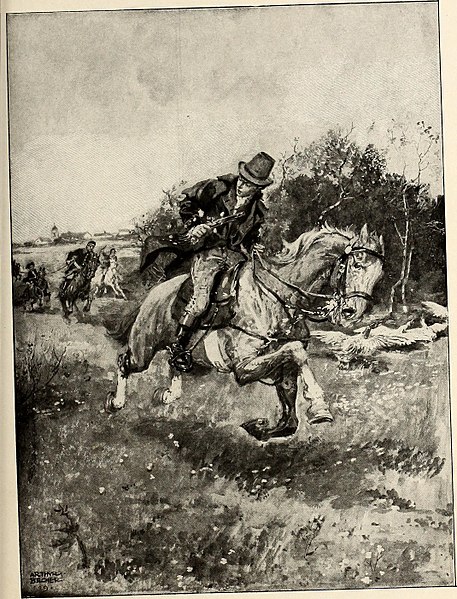
What is a highwayman?
Highwaymen as they were dubbed in Britain, were outlaws who plied their trade along the travelled highways of the world. In other parts of the world, they were known as land-pirates, mail-coach robbers, stagecoach robbers, road agents, or bushrangers. In the British Isles, they were active for the 200 years between the early 17th and 19th centuries.
The Life and Times of Jerry Abershawe
Jerry Abershawe is certainly not the best-remembered of highwaymen. However, the 19th century outlaw was notorious in his day for his particular sardonic sense of humour. He is perhaps best known for the fact that he was the last highwayman whose body was publicly displayed after execution. Here’s a brief account of the life and times of ‘the Laughing Highwayman’ Jerry Abershawe.

Image credit: Flickr ‘The Commons’
Early Life
Louis Jeremiah Abershawe, better known as Jerry Abershawe (also Abershaw or Avershaw), was born in Kingston upon Thames in 1773. By his mid-teens, he was already working as a post-chaise carriage driver but would soon become involved in a life of crime. At age just seventeen Abershawe formed a gang of highway robbers who based themselves at the Bald-Faced Stag Inn in Kingston. The notorious gang hunted down their victims on the roads between London, Kingston and Wimbledon. The gang’s prime targets were the stagecoaches of the aristocracy. These frequently passed over the extensive wild common lands that surrounded South London
Evading Capture
For some five years, Abershawe managed to evaded capture by the authorities. One of his favourite known hiding places was a house in Clerkenwell, near Saffron Hill, known as the “Old House in West Street”. The house was noted for its dark closets, trap doors and sliding panels. Other famed highwaymen, including Jack Sheppard and Jonathan Wild, were also known to have stayed there. One of his frequent partners in crime during this period was another notorious highwayman, “Galloping Dick” Ferguson.
Arrest and Imprisonment
In January 1795, Jerry Abershawe was apprehended by two police constables while drinking at the ‘The Three Brewers’ in Southwark. The highwayman produced two pistols and then fired them simultaneously at the officers, killing David Price and seriously injuring Bernard Turner. He was arrested and imprisoned that day.
In July 1795, Abershawe was brought to trial at Surrey Assizes. Reportedly, there was a legal flaw in his murder indictment that invalidated the case against him. However, he was still convicted and sentenced to death on the second charge of felonious shooting.
The trial reputedly only lasted three minutes, whereupon a contemptuous Abershawe asked the judge if he thought it was right that ”he was to be murdered by the evidence of one witness”. Playing to the gallery, he then went on to mimic the act of Judge Penryn putting on his black cap to pass the death sentence. In the intervening days between his conviction and execution, he spent the time sketching scenes from his own daring exploits on the walls of his cell.
Execution and Public Display
On Monday 3 August 1795, Abershawe was driven by ox cart to the nearby Kennington Common, the scene of many of his crimes. He put on a show of high spirits and held banter with some of his old acquaintances who had gathered in the large crowd. He kicked off his boots, laughingly explaining to the public that he wanted to disprove his mother’s prediction that he would die with them on. Abershawe did not make any final statement nor a dying confession. After he was hung, the dead body was gibbeted at the site which is still known as Jerry’s Hill.
The body was then taken to Putney Bottom, where it was strung up on chains and put on public display. The gesture from the authorities was to serve as a stark reminder to others about the consequences of crime. The body was soon pecked clean by crows with the bones and snippets of clothing being taken by the general public as mementoes. Jerry Abershawe was the last criminal to have his body dismembered and publicly displayed on gallows in such a fashion.
The Legend of Jerry Abershawe
Abershawe’s apparent show of aplomb and nonchalance with which he had met his death made him a popular figure. His obvious contempt for the establishment meant he found favour with the masses. His notoriety lived on for more than 50 years after his death. Abershawe’s name soon became synonymous with any daring act of robbery.
In 1826, Jerry Abershawe’s life was dramatised in the popular ‘The Rum-Padder of 95’. It was staged at the Royal Coburg Theatre, (now ‘The Old Vic’) in Waterloo, Lambeth. In 1828, his ghost appeared as a character in ‘The Haunted Inn’, which showed at the Drury Lane Theatre. Later, in 1842, ‘Jerry Abershaw the Highwayman’, featured at the Queen’s Theatre, Tottenham Street. Henry Downes Miles wrote a serialised novel, ‘Jerry Abershaw, or the Mother’s Curse’, which was published 1847–8, and later dramatised as ‘The Life and Death of Jerry Abershaw: The Highwayman’.
In February 1844, the London and Sporting Chronicle listed the racehorse “Jerry Abershaw”, which was trained at Epsom, by W. Lumley for Mr Drinkald. In 1912, British artist, Joseph Ratcliffe Skelton, produced a watercolour of Abershawe which was simply entitled, ‘Jerry Abershaw Highwayman’.
If you’ve enjoyed reading this article, you can find other features on notorious highwaymen by clicking on https://www.fiveminutesspare.com/education/category/people/highwaymen/






seo link building services
zxpoibdpq ghmmo hqsvotr gxfd jkktmeyqjfcumdu
… [Trackback]
[…] Find More Info here to that Topic: fiveminutesspare.com/education/highwaymen-jerry-abershawe/ […]
… [Trackback]
[…] Find More Information here on that Topic: fiveminutesspare.com/education/highwaymen-jerry-abershawe/ […]
… [Trackback]
[…] Information to that Topic: fiveminutesspare.com/education/highwaymen-jerry-abershawe/ […]
… [Trackback]
[…] Information to that Topic: fiveminutesspare.com/education/highwaymen-jerry-abershawe/ […]
… [Trackback]
[…] Info to that Topic: fiveminutesspare.com/education/highwaymen-jerry-abershawe/ […]
… [Trackback]
[…] Find More on to that Topic: fiveminutesspare.com/education/highwaymen-jerry-abershawe/ […]
… [Trackback]
[…] Here you will find 60788 additional Information on that Topic: fiveminutesspare.com/education/highwaymen-jerry-abershawe/ […]
… [Trackback]
[…] Info to that Topic: fiveminutesspare.com/education/highwaymen-jerry-abershawe/ […]
… [Trackback]
[…] Read More on on that Topic: fiveminutesspare.com/education/highwaymen-jerry-abershawe/ […]
… [Trackback]
[…] Find More to that Topic: fiveminutesspare.com/education/highwaymen-jerry-abershawe/ […]
… [Trackback]
[…] Information to that Topic: fiveminutesspare.com/education/highwaymen-jerry-abershawe/ […]
… [Trackback]
[…] Read More Information here on that Topic: fiveminutesspare.com/education/highwaymen-jerry-abershawe/ […]
… [Trackback]
[…] Info on that Topic: fiveminutesspare.com/education/highwaymen-jerry-abershawe/ […]
… [Trackback]
[…] Information on that Topic: fiveminutesspare.com/education/highwaymen-jerry-abershawe/ […]
… [Trackback]
[…] Read More Information here to that Topic: fiveminutesspare.com/education/highwaymen-jerry-abershawe/ […]
… [Trackback]
[…] Find More Information here to that Topic: fiveminutesspare.com/education/highwaymen-jerry-abershawe/ […]
… [Trackback]
[…] Information on that Topic: fiveminutesspare.com/education/highwaymen-jerry-abershawe/ […]
… [Trackback]
[…] There you can find 59871 more Info to that Topic: fiveminutesspare.com/education/highwaymen-jerry-abershawe/ […]
… [Trackback]
[…] Here you will find 80709 more Information to that Topic: fiveminutesspare.com/education/highwaymen-jerry-abershawe/ […]
… [Trackback]
[…] Find More Info here to that Topic: fiveminutesspare.com/education/highwaymen-jerry-abershawe/ […]
… [Trackback]
[…] Here you can find 52281 additional Info on that Topic: fiveminutesspare.com/education/highwaymen-jerry-abershawe/ […]
… [Trackback]
[…] Information to that Topic: fiveminutesspare.com/education/highwaymen-jerry-abershawe/ […]
… [Trackback]
[…] Information to that Topic: fiveminutesspare.com/education/highwaymen-jerry-abershawe/ […]
… [Trackback]
[…] Read More on that Topic: fiveminutesspare.com/education/highwaymen-jerry-abershawe/ […]
… [Trackback]
[…] Read More on that Topic: fiveminutesspare.com/education/highwaymen-jerry-abershawe/ […]
… [Trackback]
[…] Find More on that Topic: fiveminutesspare.com/education/highwaymen-jerry-abershawe/ […]
… [Trackback]
[…] Read More to that Topic: fiveminutesspare.com/education/highwaymen-jerry-abershawe/ […]
… [Trackback]
[…] Info on that Topic: fiveminutesspare.com/education/highwaymen-jerry-abershawe/ […]
… [Trackback]
[…] Read More on on that Topic: fiveminutesspare.com/education/highwaymen-jerry-abershawe/ […]
… [Trackback]
[…] Here you will find 96066 additional Info on that Topic: fiveminutesspare.com/education/highwaymen-jerry-abershawe/ […]
… [Trackback]
[…] There you can find 55617 more Info on that Topic: fiveminutesspare.com/education/highwaymen-jerry-abershawe/ […]
… [Trackback]
[…] Here you will find 70824 more Information to that Topic: fiveminutesspare.com/education/highwaymen-jerry-abershawe/ […]
… [Trackback]
[…] Read More Information here to that Topic: fiveminutesspare.com/education/highwaymen-jerry-abershawe/ […]
… [Trackback]
[…] Find More Information here to that Topic: fiveminutesspare.com/education/highwaymen-jerry-abershawe/ […]
… [Trackback]
[…] Find More Information here on that Topic: fiveminutesspare.com/education/highwaymen-jerry-abershawe/ […]
… [Trackback]
[…] Info to that Topic: fiveminutesspare.com/education/highwaymen-jerry-abershawe/ […]
… [Trackback]
[…] Read More here to that Topic: fiveminutesspare.com/education/highwaymen-jerry-abershawe/ […]
… [Trackback]
[…] Find More to that Topic: fiveminutesspare.com/education/highwaymen-jerry-abershawe/ […]
… [Trackback]
[…] Find More Information here on that Topic: fiveminutesspare.com/education/highwaymen-jerry-abershawe/ […]
… [Trackback]
[…] Find More Info here on that Topic: fiveminutesspare.com/education/highwaymen-jerry-abershawe/ […]
… [Trackback]
[…] Find More to that Topic: fiveminutesspare.com/education/highwaymen-jerry-abershawe/ […]